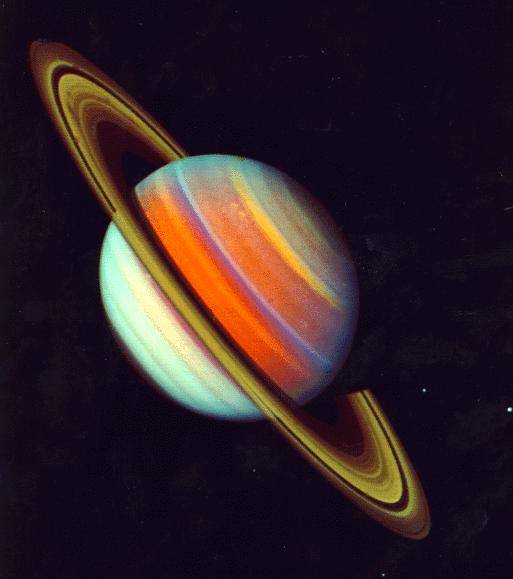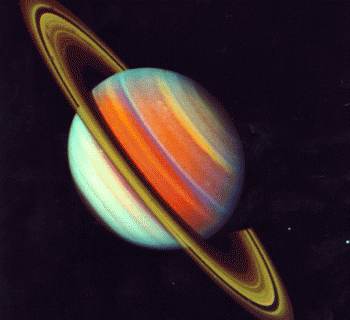The Planets
The planets that circle through our solar system guide the various systems of the natural world through the influences of the twelve signs. Each of the planets is assigned the name of a greek diety. People often get the wrong idea and think the planets were named after the dieties; in actual fact, the dieties were named after the planets. The Greeks had a complicated system of astrology and their mythological system was an interplay of the planets and their orbits, translated into textual form. Thus, studying the greek dieties will give one insight into the planets they were named after. Since this introduction speaks purely about birthcharts we will only deal with the planets as they are reflected in people, as the faculties of a person's psyche.
The ten planets are split into three groups: the two great luminaries, the four inner planets and the four outer planets.
The Great Luminaries
The Sun and the Moon are the two most important planets in the birth chart. The Sun determines a person's outer personality - how others see the person - while the Moon determines a person's inner personality - how the person sees himself. The four inner planets are all variations and associations regarding the sun, while the four outer planets are all variations and associations regarding the moon. Thus, the inner planets have to do with the outer personality and the outer planets have to do with the inner personality.
The Sun has a cycle of exactly one gregorian year, since the gregorian year is based on the cycle of the sun. Thus there are twelve divisions of the year corresponding with the twelve starsigns. The position of the starsigns doesn't match up exactly with the gregorian months, instead they start and end around the 20th to 24th of each month. A person's sunsign is the most commonly known and when a person says 'I'm a ____', they usually mean 'my sun is in ____'. Thus, finding information on sunsigns isn't difficult. The Moon has a cycle of roughly 29 days. This means it changes signs roughly every two and a half days. The way a person views himself, his self-image/inner personality, is determined by the sign in which the moon was in at the time of a person's birth. Thus, for example, the moon in Ares will mean a person views himself as being a driven and confrontational person, or one with his moon in Virgo will see himself as being pure and controlled. The essence of a person's perspective of his actions is his moon and thus his reasons for doing what he does is thought to be derived from this sign.
The interplay between the inner self and the outer self is a deep and complicated one. It could take volumes and volumes to expound on just this topic. It's not a very practical analogy, but I like to think of it like a sheet of paper with writing on both sides. What's written on one side can have very little to do with what's written on the other side; but if something wrinkles one side of the paper both sides will be affected. They change will just appear differently on both sides.
A practical example: Jim has a Sun in Taurus and a Moon in Cancer. On the outside, he acts in a very stubborn and stable way, sticking to his perspectives. He views himself, however, as having dramatic mood changes and being a very sensitive and caring person, which doesn't show up at all in his external behaviour. In fact, it could happen that a person comes up to Jim and insult him right to his face, to which he will not react at all, merely shrugging his shoulders while on the inside he is struck with an intense pain at being struck such a heavy blow. The external apathy isn't due to repressing emotions, it's due to a natural disconnect between the inner world and the outer one. In fact, the external apathy may be said to be the reaction of the intense sorrow - Jim just shutting down, closing up and turning away as the external reaction to his internal pain. If the same thing happened to John, who also has a Moon in Cancer but a Sun in Gemini, he would feel equally wounded by the insult but he would fly into a verbal frenzy, probably shaming the insulter terribly due to the natural Gemini wit.
A person can only know his external self (sun sign) through honest reflection and observation, and by asking those on the outside. A person can only know another person's internal self (moon sign) by asking the other person and receiving an honest answer. This does indeed imply that a person remains very much unaware of his own external personality, and that we are all very much unaware of the very different inner worlds that every person lives in.
One may ask at this point which of the two selves is the true self. The answer is neither. This will be elaborated when we get to the Houses, specifically talking about the Ascendent. Note also that both the sun sign and the moon sign can be expounded in elaborate detail and when taken together in any given individual a whole book can be written describing the individual's personality dynamics. What I have presented is less than a sample to introduce the concepts.
The Inner Planets
There are four inner planets: Mercury, Venus, Mars and Jupiter. These planets all build on the external 'Sun' nature of a person. Venus is a slight exception in that it builds on the external but is expressed internally. All these planets have an orbit of less than 12 years. Jupiter's orbit is almost exactly 12 years long, which means it moves into a different sign roughly once a year. Thus, these planets are mostly individualized.
Mercury hugs the sun closely, never going further than one sign away from it in either direction. It is therefore the most associated with the external self. Very often sunsign descriptions include Mercury into their descriptions, sometimes consciously sometimes unconsciously, because more often than not they are found in the same sign. In fact, the influence of Mercury is very subtle and often overlooked. Mercury is the planet of Communication. It determines how a person communicates with the outside world.
Venus also hugs the sun closely, but can stray up to two signs away, not just one. Venus is an internal planet expressed externally, making it one of the three gateways between the Moon and Sun selves. The other two are Uranus and The Ascendant. Venus is the planet of Attraction. It is the force that pulls a person to his desires and emotional fulfillments. It is not the planet that fulfills; that is more of a moon thing. It merely dictates what a person will think he will be fulfilled by.
Mars is the driving force that fuels a person's actions. It determines what kind of ambition and motivation a person has, in what areas of life he best has them, how intense his drives are, and so on. Note that Venus pulls in different directions and Mars pushes in different directions. These two planets have an interesting relationship, not only conceptually but also mathematically and, if you look into mythology, their romantic affair is very clearly portrayed therein.
Jupiter is the 'commander' of the external self. In our solar system it is the guardian of the inner planets, stopping many meteors from entering. From a different perspective one could say that Jupiter is responsible for all the meteors that enter our solar system, which might be part of the planet's association with smiting from the heavens (Jupiter being the roman name for the greek Zeus). This planet is very strongly associated with Law and Justice, being the commander of the external social world. In an individual, however, it applies more closely to the opportunities a person has in his lifetime. For example, should Jupiter be in Leo it means a person will have alot of opportunities to be in the spotlight, or if it were in Libra it means that very often a person will be put in the role of Mediator and will have alot of resources when it comes to mediating his and other disputes.
The Outer Planets
There are four outer planets: Saturn, Uranus, Neptune and Pluto. These planets all build on the internal 'Moon' nature of a person. Uranus is a slight exception in that it builds on the internal but is expressed externally. These planets all have long orbits, from Saturn's 29 year orbit to Pluto's 248 year orbit. Thus these planets all have to do more with society as a whole than with specific individuals.
Saturn is nicknamed 'the father'. This is for two reasons: First, because Saturn is the roman name for 'Cronos' who was the titan father of all the dieties (who was subsequently 'slain' and trapped in 'tartarus' by the Jupiter, who took command of the heavens from him). Secondly, because the associations that Saturn has are the same as the father's role in raising a child. Saturn is the planet associated with punishment, obstacles and character refinement. Jupiter expands horizons, Saturn restricts them. Saturn determines the area in which a person will be challenged in his lifetime which is the means through which his soul will be refined and prepared for the next world.
Uranus, like Venus, is a gateway between worlds. It determines a person's social identity: what is considered cool/uncool. It changes signs every 7 years, meaning that the great majority of a person's peers will have the same social identity as him. Uranus is usually expressed in mode of dress, hobbies and circles of friends.
Neptune determines a person's imagination. It changes signs every 13-14 years, meaning that almost all of a person's peers will share the same abilities and modalities of imagination. For example, those born between the years of 1971-1985 have a Neptune in Saggitarius, meaning alot of active dreams about adventure and excitement, which inspires the creativity of the generation in general terms, influencing the types of creative works these people would be interested in producing and consuming.
Pluto has an erratic orbit, moving from one sign to another roughly every 20 years. It is the 'commander' of the inner self, mirroring Jupiter in many ways. Pluto is the roman name for the greek Hades, who is the ruler of the underworld (the subconscious universe). It determines the moral standards of every individual and of society as a whole. This planet, I believe, is the primary element responsible for the 'generation gap' between parents and children, whose moral values very often clash so dramatically - not only in recent times but all throughout history. For example, from 1939-1957 Pluto was in Leo, marking a generation born who would be concerned very much with politics, hierarchical structures, loyalty, success and leaving behind a strong legacy. The next generation, from 1957-1971, would be born under a Pluto in Virgo, whose moral vision is more about awareness, purity, earthiness and passiveness. The Pluto in Leo parents had a very difficult time with their Pluto in Virgo children, the moral gap being enormous.
Chiron and The Asteroid Belt
Recently, a small astral body has been found between Jupiter and Saturn. This astral body was named after Chiron, a centaur advisor to Jupiter. Modern astrologers have associated Chiron with Libra, replacing its previous association with Venus, and with an individual's conscience. I haven't studied this planet so much, but it is slowly working its way into the mainstream.
This leaves the only sign without a unique planet as Virgo. I heard an interesting theory about Virgo's planet which I would like to share for your consideration:
Virgo no longer has a planet. The planet that used to be associated with Virgo is now the scattered rocks we call the Asteroid Belt, which was destroyed when struck by a massive meteor some tens of thousands of years ago. This means the planet that should be associated with the faculty of Perception is now scattered from a specific perspective into a general static of doubt and confusion. There are astrologers who try to map out the major asteroids in the belt and find out what their specific sub-attributes are. There are a few who say they found the core of the former planet, which would mark out where the center of a person's perception would lie. I haven't done a whole lot of research into this area yet so I hesitate to present any actual data. All the asteroids that have been mapped out, however, have been associated with different aspects of perception, inspiration and otherworldliness.
Putting it all together
It takes either a good measure of intuition or alot of level-headed research to be able to assemble the signs with the planets. The twelve signs with the ten planets make 120 combinations which are all so detailed that a full essay and more can be written on each of them. Thus, the path of knowledge in Astrology is a long and difficult one. I personally have not memorized 120 planetary associations. Firstly because I find working out the interplay between planets in different signs to be more important than getting an accurate description of the planets as individuals. Still, knowing them individually is necessary to be able to associate them with each other properly. Thus, the method I use is based on key-words/key-concepts. Getting to know the zodiac intimately and the character of all the planets as well. Then associations can be made by plugging them in to each other and expanding on the combination. Thus, if we take Cancer and Venus together, we see that Cancer is about Caring and Venus is the power of Attraction. This means that a person with Venus in Cancer would be attracted to weakness and injury, to things that a person can take care of. It would also mean that romantically this person would be attracted to people with chronic conditions that need to be cared for. Alternately, this person could be attracted to a person who is equally caring with the desire to work together with this partner in order to take care of others. Also, this person would easily make friends with needy people and other caring individuals. One could then expand on this through the Cancer's love of comfort and having a place to call his own, through venus's association with the lips and facial expressions, through venus's role as a gateway between worlds, and so on.
End of Part 1.1
I hope this article is sufficient to spark your interest into the world of Astrology and give you a hint of the vast science that it is.
Yeremiah Moshe Hornick
May 2007








